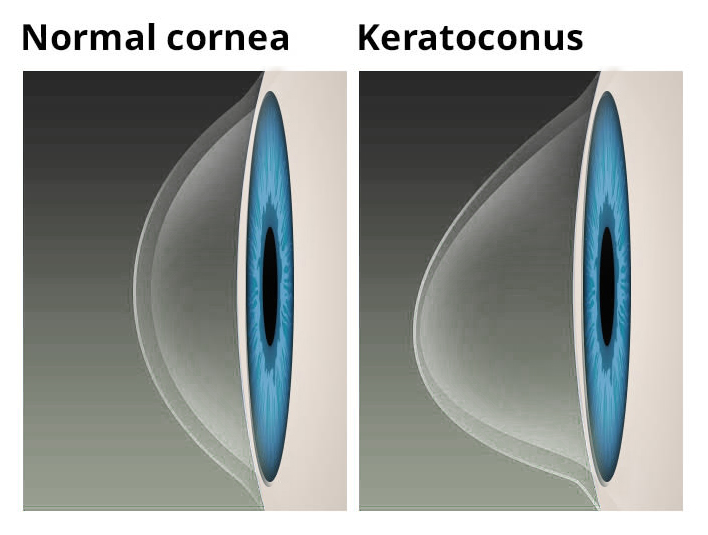“There are a lot of complex words in the eye care world and keratoconus is one of them. What is this condition and why can patients only wear contact lenses to see clearly?"
Keratoconus is an eye disease where the cornea (the clear curved front surface of the eye) thins and gradually bulges out into an irregular cone shape.
This causes patients to experience distorted/blurred vision and sensitivity to light and glare. Keratoconus usually starts in the late teens to early 30s, gradually progresses throughout life and can become severe if left untreated. The definitive cause of keratoconus is unknown, but it is believed to be linked to genetics and allergies.

TREATING KERATOCONUS
In the early stages of keratoconus, we can use eyeglasses and soft contact lenses to achieve good-quality vision. But as the cornea continues to thin, the eye doctor may need to switch to rigid contact lenses to create a new front surface for the eye and cover the severely irregular cornea.
Because the cornea is so irregular, the contact lenses and fitting required can be complicated and expensive. And because this is the best solution for these patients to achieve clear vision, contacts lenses are deemed medically necessary.
What are medically necessary contact lenses?
Medically necessary contact lenses are not elective, or stated differently, not for cosmetic reasons. Medically necessary indicates this is the best choice for the patient’s optimal vision outcome. With this benefit, Surency will pay the provider for the additional testing and lens costs above the standard cost of traditional contact lenses. Medically necessary contact lenses are filed as a “paid-in-full” benefit which does not allow for provider balance billing.
Are there other treatments for keratoconus?
A chemical, light-cured procedure called corneal collagen cross-linking may help to slow or stabilize keratoconus from progressing by strengthening the corneal collagen fibers.
Who is eligible for the medically necessary contact lens benefit?
- Patients with keratoconus where the patient can’t achieve good vision with eyeglasses (worse than 20/25 with glasses.)
- Patients with a significant difference in prescription between their eyes. This can create distortion and double vision while wearing glasses that doesn’t exist when wearing contact lenses (anisometropia exceeding 3D.)
- Patients with very high prescriptions (greater than - 10D or +10D) in at least one eye.
- Patients whose vision can be corrected by two lines of improvement on the visual acuity chart with contact lenses but not with eyeglasses.
Ask your Surency representative if you have questions.
Learn More About Surency Vision
Source: Eyemed